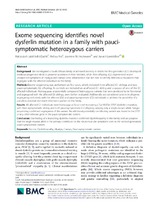| dc.contributor.author | Jalali-Sefid-Dashti, Mahjoubeh | |
| dc.contributor.author | Nel, Melissa | |
| dc.contributor.author | Heckmann, Jeannine M. | |
| dc.contributor.author | Gamieldien, Junaid | |
| dc.date.accessioned | 2018-06-13T10:17:58Z | |
| dc.date.available | 2018-06-13T10:17:58Z | |
| dc.date.issued | 2018 | |
| dc.identifier.citation | Jalali-Sefid-Dashti, M. et al. (2018). Exome sequencing identifies novel dysferlin mutation in a family with paucisymptomatic heterozygous carriers. BMC Medical Genetics, 19: 95 | en_US |
| dc.identifier.issn | 1471-2350 | |
| dc.identifier.uri | https://doi.org/10.1186/s12881-018-0613-x | |
| dc.identifier.uri | http://hdl.handle.net/10566/3801 | |
| dc.description.abstract | BACKGROUND: We investigated a South African family of admixed ancestry in which the first generation (G1) developed
insidious progressive distal to proximal weakness in their twenties, while their offspring (G2) experienced severe
unexpected symptoms of myalgia and cramps since adolescence. Our aim was to identify deleterious mutations that
segregate with the affected individuals in this family.
METHODS: Exome sequencing was performed on five cases, which included three affected G1 siblings and two
pauci-symptomatic G2 offspring. As controls we included an unaffected G1 sibling and a spouse of one of the G1
affected individuals. Homozygous or potentially compound heterozygous variants that were predicted to be functional
and segregated with the affected G1 siblings, were further evaluated. Additionally, we considered variants in all genes
segregating exclusively with the affected (G1) and pauci-symptomatic (G2) individuals to address the possibility of a
pseudo-autosomal dominant inheritance pattern in this family.
RESULTS: All affected G1 individuals were homozygous for a novel truncating p.Tyr1433Ter DYSF (dysferlin) mutation,
with their asymptomatic sibling and both pauci-symptomatic G2 offspring carrying only a single mutant allele. Sanger
sequencing confirmed segregation of the variant. No additional potentially contributing variant was found in the DYSF
or any other relevant gene in the pauci-symptomatic carriers.
CONCLUSION: Our finding of a truncating dysferlin mutation confirmed dysferlinopathy in this family and we propose
that the single mutant allele is the primary contributor to the neuromuscular symptoms seen in the second-generation
pauci-symptomatic carriers. | en_US |
| dc.language.iso | en | en_US |
| dc.publisher | BioMed Central | en_US |
| dc.rights | © The Author(s). 2018 Open Access This article is distributed under the terms of the Creative Commons Attribution 4.0
International License (http://creativecommons.org/licenses/by/4.0/), which permits unrestricted use, distribution, and
reproduction in any medium, provided you give appropriate credit to the original author(s) and the source, provide a link to
the Creative Commons license, and indicate if changes were made. The Creative Commons Public Domain Dedication waiver
(http://creativecommons.org/publicdomain/zero/1.0/) applies to the data made available in this article, unless otherwise stated. | |
| dc.subject | Exome | en_US |
| dc.subject | Dysferlinopathy | en_US |
| dc.subject | Myalgia | en_US |
| dc.subject | Cramps | en_US |
| dc.subject | Pauci-symptomatic carriers | en_US |
| dc.title | Exome sequencing identifies novel dysferlin mutation in a family with paucisymptomatic heterozygous carriers | en_US |
| dc.type | Article | en_US |
| dc.privacy.showsubmitter | FALSE | |
| dc.status.ispeerreviewed | TRUE | |

